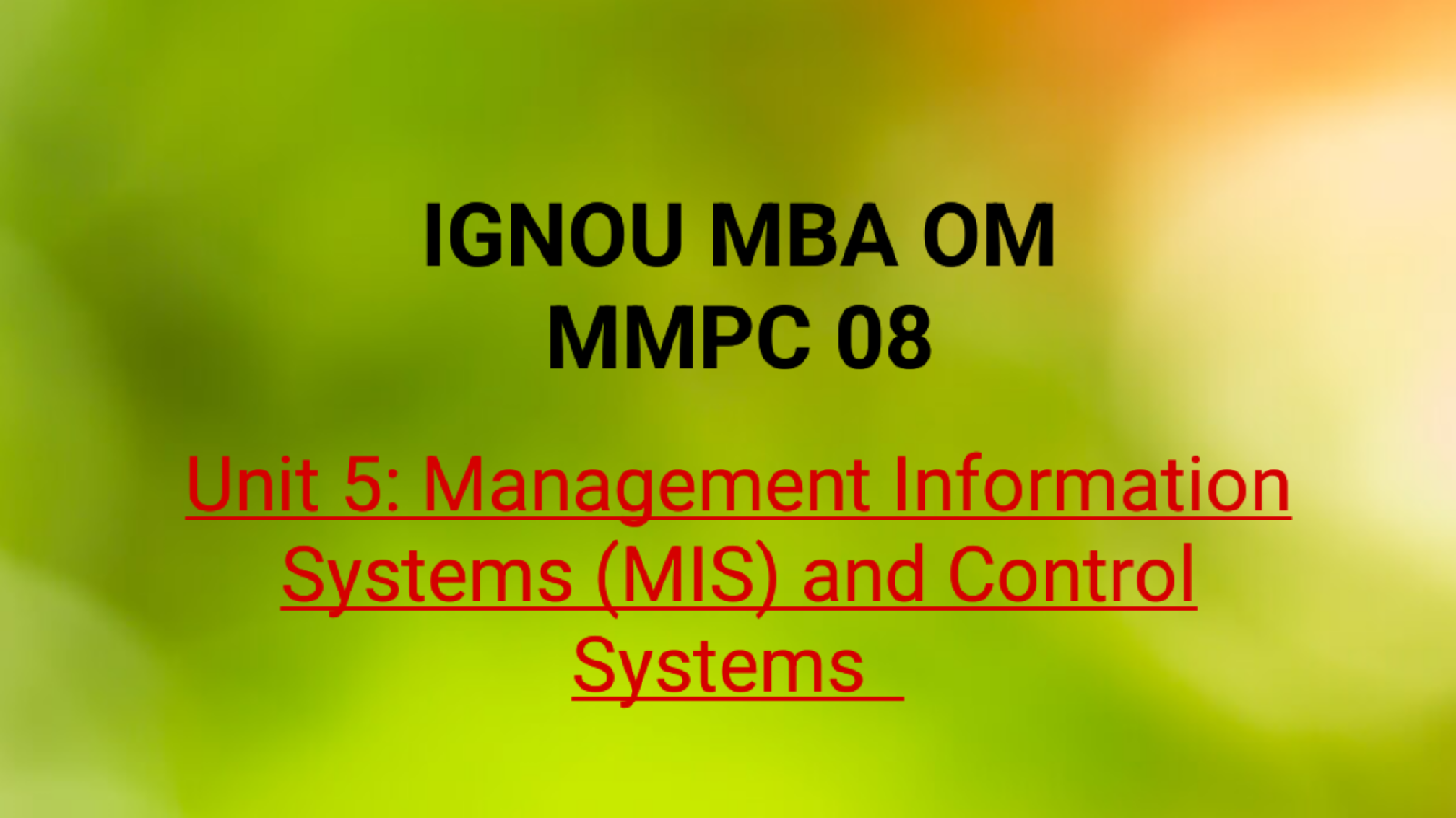IGNOU MBA MMPC-08: Information Technology for Managers
Unit 5: Management Information Systems (MIS) and Control Systems
Introduction
Management Information Systems (MIS) play a crucial role in modern businesses by collecting, processing, and analyzing data to support decision-making. Control systems ensure operational efficiency and compliance with organizational goals. This unit explores the concepts, components, and applications of MIS and control systems.
1. Management Information Systems (MIS) Overview
1.1 Definition of MIS
MIS is a structured combination of people, processes, technology, and data that helps in decision-making and business operations.
1.2 Objectives of MIS
- Facilitate decision-making.
- Improve efficiency and productivity.
- Provide accurate and timely information.
- Support strategic planning and control.
1.3 Characteristics of MIS
- Systematic approach – Organized structure for handling data.
- Integrated system – Connects different business functions.
- User-friendly interface – Simplifies data access.
- Real-time processing – Ensures quick decision-making.
2. Components of MIS
2.1 Hardware
- Computers, servers, networking devices.
- Data storage systems.
2.2 Software
- Database Management Systems (DBMS).
- Enterprise Resource Planning (ERP) software.
- Business intelligence tools.
2.3 Data
- Raw facts and figures used for processing information.
- Stored in structured or unstructured formats.
2.4 People
- End-users, IT professionals, and decision-makers.
2.5 Processes
- Methods to collect, analyze, and distribute information.
3. Types of MIS
3.1 Transaction Processing Systems (TPS)
- Handles daily business transactions.
- Example: Point of Sale (POS) systems.
3.2 Decision Support Systems (DSS)
- Analyzes large datasets for strategic decision-making.
- Example: Data analytics platforms.
3.3 Executive Information Systems (EIS)
- Provides top executives with summarized reports.
- Example: Corporate dashboards.
3.4 Enterprise Resource Planning (ERP) Systems
- Integrates all business functions into a single system.
- Example: SAP, Oracle ERP.
3.5 Knowledge Management Systems (KMS)
- Facilitates knowledge sharing and collaboration.
- Example: Intranet portals.
4. Control Systems in MIS
4.1 Definition of Control Systems
A control system is a set of procedures that monitor and guide business operations to ensure compliance with goals and policies.
4.2 Types of Control Systems
- Open-loop control system – No feedback mechanism.
- Closed-loop control system – Uses feedback for adjustments.
4.3 Importance of Control Systems in MIS
- Ensures accuracy and consistency in data processing.
- Prevents fraud and security breaches.
- Enhances efficiency in business operations.
5. Role of MIS in Decision-Making
5.1 Strategic Decision-Making
- Long-term planning and market analysis.
5.2 Tactical Decision-Making
- Resource allocation and process improvements.
5.3 Operational Decision-Making
- Day-to-day business functions.
5.4 Examples of MIS in Various Industries
- Healthcare: Electronic health records (EHR).
- Retail: Inventory management systems.
- Finance: Automated trading systems.
6. Practical Applications and Experiments
6.1 Experiment: Using an ERP System for Data Management
Objective: Understand how ERP integrates business processes.
Steps:
- Login to an ERP system.
- Enter transactional data.
- Generate reports for analysis.
6.2 Experiment: Implementing a Decision Support System (DSS)
Objective: Analyze data for better decision-making.
Steps:
- Input business data into a DSS tool.
- Apply analytical models.
- Generate insights for strategic planning.
7. Assignment Questions
- Define MIS and explain its objectives.
- Discuss the components of MIS with examples.
- What are the different types of MIS? Provide real-world applications.
- Explain the role of control systems in MIS.
- How does MIS aid decision-making in businesses?
8. Self-Study Questions
- How does MIS differ from traditional information systems?
- What are the advantages of ERP in business operations?
- Explain the importance of data security in MIS.
- How can DSS help managers make better decisions?
- Discuss a real-life example of MIS implementation.
9. Exam Questions
Short Answer Questions:
- Define control systems in MIS.
- List three examples of MIS applications.
- What is the role of a database in MIS?
- Explain the concept of feedback in control systems.
- What are the advantages of ERP systems?
Long Answer Questions:
- Explain different types of MIS and their significance.
- Discuss how MIS supports decision-making at different organizational levels.
- What are the key components of a control system? Provide examples.
- Compare and contrast open-loop and closed-loop control systems.
- Describe the role of MIS in the banking sector.
Conclusion
This unit provides an in-depth understanding of MIS and control systems, their role in business operations, decision-making, and strategic planning. Effective MIS implementation helps organizations improve efficiency, security, and overall performance.
Here is the complete class for Unit 5: Management Information Systems (MIS) and Control Systems of IGNOU MBA MMPC-08. It includes all essential theories, components, experiments, assignment questions, self-study questions, and exam questions. Let me know if you need any modifications or additional details!





















